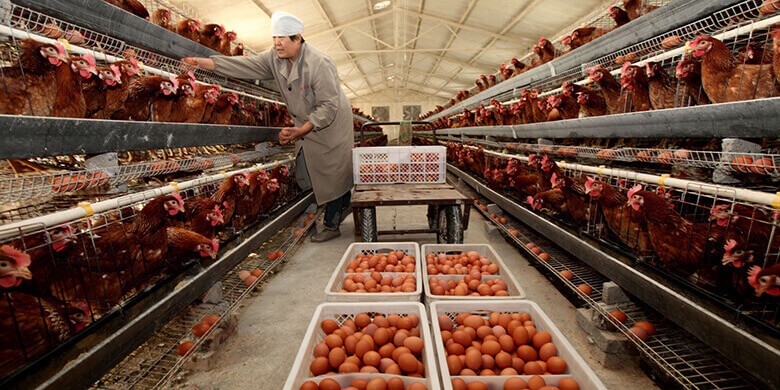Poultry farming is one of the fastest-growing sectors in India’s agriculture and livestock industry. Among its various types, layer farming—the rearing of chickens for egg production—is a highly profitable and sustainable business model. With rising protein consumption, growing demand for eggs in households, restaurants, and bakeries, and government support for agri-based ventures, poultry layer farming presents a golden opportunity for aspiring entrepreneurs and farmers.
Here’s a comprehensive guide to starting your own poultry layer farming business in India:
1. What is Layer Poultry Farming?
Layer poultry farming involves the rearing of laying hens (layers) specifically for commercial egg production. These birds start laying eggs from the age of 18–20 weeks and can continue for up to 72–80 weeks.
2. Advantages of Layer Farming
-
High demand for eggs all year round
-
Fast return on investment
-
Employment generation
-
Requires less space and water compared to broiler farming
-
Government schemes and subsidies available
3. Types of Layer Birds
There are two main categories of layers:
-
White Egg Layers – Light-weight birds, higher egg production (e.g., White Leghorn)
-
Brown Egg Layers – Heavier birds, preferred for brown eggs (e.g., Rhode Island Red)
Choose based on regional preferences and market demand.
4. Business Model and Scale
You can choose based on your investment and land availability:
| Farm Size | Number of Birds | Investment Range (₹) |
|---|---|---|
| Small scale | 500–1,000 | ₹2–5 lakhs |
| Medium scale | 2,000–5,000 | ₹5–15 lakhs |
| Large scale | 10,000+ | ₹20 lakhs and above |
5. Planning and Setup
✅ Step 1: Farm Location
Choose a well-drained, pollution-free area with good ventilation and access to clean water, electricity, and roads. Avoid residential zones.
✅ Step 2: Housing (Shed Construction)
Common poultry housing systems:
-
Deep Litter System (cheaper, requires more space)
-
Battery Cage System (efficient for egg collection, hygiene, but costlier)
Shed requirements:
-
Adequate ventilation
-
East-west orientation
-
Provision for light and temperature control
-
Protection from predators
✅ Step 3: Equipment Required
-
Feeder and drinkers
-
Battery cages or nesting boxes
-
Lighting systems
-
Egg collection trays
-
Water tank and storage
-
Manure removal tools
-
Brooding equipment (for young chicks)
6. Procurement of Chicks
Source Day-Old Chicks (DOC) from certified hatcheries. Ensure they are vaccinated and of high-yielding egg-laying varieties. Examples include:
-
ISA Brown
-
Lohmann Brown
-
Hy-Line
-
BV 300
7. Feeding and Nutrition
Proper feed ensures better egg production and hen health.
Feed Stages:
-
Starter Feed (0–8 weeks)
-
Grower Feed (9–18 weeks)
-
Layer Feed (18+ weeks)
The feed must be rich in calcium, protein, and minerals. Clean drinking water should be available at all times.
8. Health Management & Vaccination
Maintain hygiene and follow a regular vaccination schedule to prevent:
-
Newcastle Disease
-
Infectious Bronchitis
-
Marek’s Disease
-
Fowl Pox
Use biosecurity measures to restrict entry of outsiders, rodents, and wild birds.
9. Egg Collection, Grading, and Storage
-
Collect eggs 2–3 times daily
-
Clean gently and sort based on size and quality
-
Store in cool, dry places or cold rooms
-
Pack in trays or cartons for delivery
Eggs can be sold to:
-
Local markets
-
Wholesale buyers
-
Retail stores and hotels
-
Supermarkets and online grocery platforms
10. Waste Management
Layer poultry farming generates a lot of manure which can be sold as organic fertilizer or used in biogas plants, adding another income stream.
11. Investment and Profitability
| Item | Approximate Cost (for 1000 birds) |
|---|---|
| Land and shed | ₹2,00,000–₹3,00,000 |
| Birds (DOC) | ₹35–₹45 per chick |
| Feed (for 72 weeks) | ₹2.5–₹3 lakhs |
| Equipment and labor | ₹1–₹1.5 lakhs |
| Total Setup Cost | ₹5–₹6 lakhs |
Returns:
-
Each bird lays ~280–320 eggs per cycle
-
Eggs sell at ₹4–₹6 each (wholesale)
-
Additional income from manure
-
Break-even in 12–18 months
12. Marketing and Sales Strategy
-
Sell directly to local stores, vendors, hotels, or egg wholesalers
-
Supply to schools, hospitals, and canteens
-
Tie up with food delivery and online platforms
-
Offer farm-fresh organic eggs for a premium price
Packaging and branding can help build trust and a loyal customer base.
13. Government Support and Subsidies
You can avail schemes and assistance through:
-
National Livestock Mission
-
Rural Poultry Development Scheme
-
NABARD Subsidies
-
State Livestock Development Boards
Udyam Registration and FSSAI License are recommended for compliance and benefits.
14. Challenges and Risk Management
-
Disease outbreaks – maintain hygiene and vaccination
-
Price fluctuations in eggs – create long-term buyer contracts
-
Feed cost increase – buy in bulk, use own feed mill if possible
-
Labor management – train and retain local workers
Starting a poultry layer farming business in India is a smart move for those looking to enter the agribusiness space with steady income and long-term potential. With proper planning, efficient farm management, and a good marketing strategy, you can build a profitable venture that also contributes to food security and rural employment.


